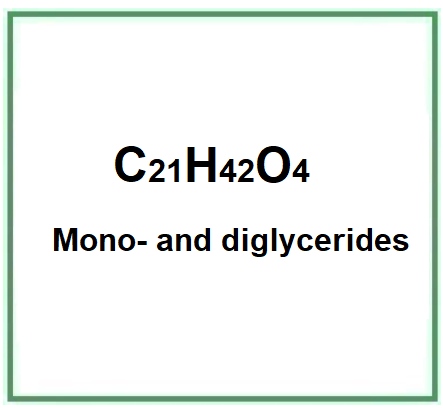Mono- and diglycerides of fatty acids (Glyceryl monostearate)
It is a chemical compound, the glycerol ester of stearic acid, and comes in the form of an odourless, hygroscopic, white granular or flaky powder. It has a slightly sweet taste, which is why it is often added to foods.

It is found in the human body as a by-product of the breakdown of fats.
From where it is extracted
Derived from glycerin E422 and from fatty acids, such as soybean oil, but also from rapeseed oil, palm oil and other oils. As the name implies, the generic term "fatty acids" does not make it possible to trace what type of oil is used, whether saturated, unsaturated or hydrogenated, or genetically modified and it can be derived from animal fats.
From fungi lipase as Malassezia globosa, Penicillium camembertii, Aspergillus oryzae (1)
What it is used for
Food
Ingredient included in the list of European food additives as E471.
It serves as a thickener, non-ionic emulsifier and stabiliser in order to refine softness and increase volume: bread, croissants, chocolate, cakes, biscuits, ice cream, pasta, panettone, corn flakes, food supplements, chips, crackers, etc.
Plastic. PVC lubricant, EPE foaming agent, PE antifogging agent.
Pharmaceutical and cosmetics. Thickener, non-ionic emulsifier and stabiliser
Safety
The estimated combined intake of E 470a, E 471 and E 477 at the maximum permitted levels could lead to a maximum total exposure of 84 mg/kg body weight (bw) per day for toddlers and 20 mg/kg bw per day for adults. Using a reference body weight of 12 kg for toddlers and of 70 kg for adults, the highest amount of emulsifiers ingested per person per day would be 1,008 mg for toddlers and 1,400 mg for adults. As a conservative approach, it could be assumed that these doses could be consumed on a single occasion (2).
Glycerol monostearate studies
Typical optimal characteristics of E471 commercial product
Appearance
| Povere bianca |
Content of Monooeaster ≥ %
| 90.0 |
Lodine value ≤ g/100g
| 3.0 |
Solidfication point ≥°C
| 60.0 |
Free Acid ≤ %
| 2.5 |
Heavy metals( as pb) ≤ ppm
| 5 |
| Lead ≤ ppm | 5 |
| Mercury ≤ ppm | 1 |
| Cadmium ≤ ppm | 1 |
Acid Value ≤
| 6 |
Free Glycerol ≤ %
| 7 |
Total Glycerol %
| 16-33 |
Sulphated ash ≤ %
| 0.5 |
Molecular Formula: C21H42O4
Molecular Weight : 358.563
CAS : 123-94-4 31566-31-1 22610-63-5 14811-92-8 85666-92-8 83138-62-9 37349-34-1
Synonyms :
Mono- and diacylglycerol, Glyceryl Monostearate, Monostearin, 1-Monostearoylglycerol, Glyceryl stearate, tegin, Stearic acid 1-monoglyceride, 2,3-dihydroxypropyl octadecanoate, Stearic acid alpha-monoglyceride
References________________________________________________________________________
(1) Yuan D, Lan D, Xin R, Yang B, Wang Y. Biochemical properties of a new cold-active mono- and diacylglycerol lipase from marine member Janibacter sp. strain HTCC2649. Int J Mol Sci. 2014 Jun 12;15(6):10554-66. doi: 10.3390/ijms150610554.
(2) Scientific Opinion related to a notification from DuPont Nutrition Biosciences Aps on behenic acid from mustard seeds to be used in the manufacturing of certain emulsifiers pursuant to Article 21(2) of Regulation (EU) No 1169/2011 – for permanent exemption from labelling
First published: 15 November 2016
EFSA DOI: 10.2903/j.efsa.2016.4631
![]() Mono-and diglycerides
Mono-and diglycerides 


